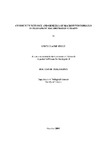Community ecology and genetics of macroinvertebrates in permanent macaronesian streams.
| dc.contributor.author | Kelly, Lucy Claire | |
| dc.contributor.other | School of Biological and Marine Sciences | en_US |
| dc.date.accessioned | 2011-09-27T10:20:28Z | |
| dc.date.available | 2011-09-27T10:20:28Z | |
| dc.date.issued | 1996 | |
| dc.identifier | Not available | en_US |
| dc.identifier.uri | http://hdl.handle.net/10026.1/738 | |
| dc.description | Merged with duplicate record 10026.1/1923 on 03.04.2017 by CS (TIS) | |
| dc.description.abstract |
Extensive community-based sampling and single-species genetic analysis were used to study factors driving stream invertebrate community assembly on islands. Macroinvertebrates and physicochemistry were surveyed in forty-two streams on La Palma, La Gomera, Tenerife and Madeira (Macaronesia). Island faunal relationships and the role of the stream and catchment environment in determining community composition were investigated with multivariate analyses; assemblage nestedness and species richness, occupancy and abundance were also examined. The relationship between genetic differentiation and range size was tested using allozyme variation in selected species. Island species pools differed in community composition and species richness (total, and endemic), broadly as predicted by theory of island biogeography. Stream and island species richness were correlated, showing unsaturated, possibly dispersal-limited, communities, and stream faunas were nested, evidence that assemblages were not random (e.g. only generalist/dispersive taxa occur at species-poor sites). Endemics occurred in more streams than non-endemics, suggesting greater habitat availability for the former, but similar niche width, endemic and non-endemics having similar local abundance. Species richness, community composition and the abundances of individual species were correlated with stream physicochemistry, itself reflecting geology, rainfall, altitudinal zonation of vegetation and the intensity of stream exploitation. Allozyme variation was surveyed in Mesophylax aspersus (Trichoptera: Limnephilidae) and Wormaldia tagananana (Trichoptera: Philopotamidae), respectively having widespread and localised distributions. Population structure supported the hypothesis that range size is, at least partly, limited by poor dispersal ability in W tagananana. Genetic variation in Ancylus striatus (Gastropoda: Ancylidae) was typical of polyploidy and selffertilisation/ parthenogenesis. Breeding system has consequences for a species' colonisation ability, and may partially explain the wide distribution of A. striatus within the islands. Variation in community composition reflected patterns at a range of scales. Biogeography detennined the island species pooL whilst local physicochemistry determined richness and community composition within islands. Species characteristics that affect their colonisation and c:\tinction probabilities (e.g. habitat selection at the local- and mesoscaks, dispersal patterns and breeding system). influence hoth the local and regional species pools . | en_US |
| dc.language.iso | en | en_US |
| dc.publisher | University of Plymouth | en_US |
| dc.title | Community ecology and genetics of macroinvertebrates in permanent macaronesian streams. | en_US |
| dc.type | Thesis | |
| dc.identifier.doi | http://dx.doi.org/10.24382/3794 | |
| dc.identifier.doi | http://dx.doi.org/10.24382/3794 |
Files in this item
This item appears in the following Collection(s)
-
01 Research Theses Main Collection
Research Theses Main


